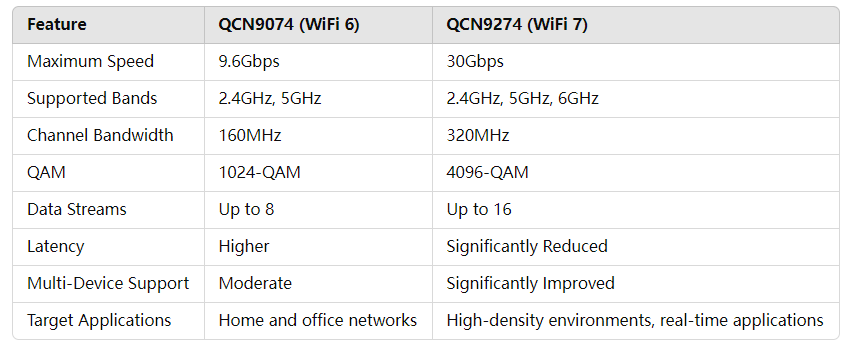|
With the continuous advancement of wireless communication technology, WiFi technology has been evolving, especially with the introduction of WiFi 6 and WiFi 7. Qualcomm, as a major player in the wireless communication field, has developed the QCN9074 and QCN9274 chips, representing the technological leap from WiFi 6 to WiFi 7. In this article, we will comprehensively analyze these two chips and explore the differences between them to help readers better understand the evolution of WiFi technology. 1. QCN9074: The Foundation of WiFi 6The QCN9074 is a chip launched by Qualcomm based on WiFi 6 technology. WiFi 6 (also known as 802.11ax) is an important advancement over WiFi 5 (802.11ac), aiming to improve network speed, reduce latency, and provide better performance in high-density environments. As a representative chip of WiFi 6, the QCN9074 has the following key features:
Higher Transmission Speed WiFi 6 supports a maximum theoretical data transfer rate of 9.6Gbps, and as a chip that supports WiFi 6, the QCN9074 provides a more stable and efficient wireless network experience. OFDMA (Orthogonal Frequency Division Multiple Access) A major innovation in WiFi 6, OFDMA allows multiple devices to communicate simultaneously on the same frequency band, reducing latency and improving overall network efficiency, particularly in high-density environments. MU-MIMO (Multi-User Multiple Input Multiple Output) Unlike WiFi 5’s SU-MIMO (Single User MIMO), WiFi 6 supports MU-MIMO, which allows multiple devices to communicate at the same time, enhancing performance in environments with many devices. TWT (Target Wake Time) TWT is an energy-saving feature in WiFi 6 that helps reduce power consumption when devices are in idle mode, which is especially important for IoT devices and mobile terminals.

2. QCN9274: A Revolution in WiFi 7WiFi 7 (also known as 802.11be) is the next-generation WiFi standard, building upon WiFi 6 with numerous innovations, particularly in transmission speed, spectrum efficiency, low latency, and multi-device support. As a representative chip of WiFi 7, the QCN9274 boasts the following key features:
Higher Transmission Speed WiFi 7 offers a maximum data transfer rate of up to 30Gbps, more than three times that of WiFi 6. The QCN9274 achieves faster wireless transmission speeds through support for wider frequency bands (such as 320MHz) and higher-order modulation techniques (such as 4096-QAM). Support for Up to 16 Data Streams WiFi 7 supports up to 16 data streams, whereas WiFi 6 supports only 8. This allows the QCN9274 to handle more data and provide simultaneous connections for more devices, increasing the overall network capacity. Advanced QAM (Quadrature Amplitude Modulation) WiFi 7 introduces an enhanced QAM technology that supports up to 4096-QAM, compared to 1024-QAM in WiFi 6. This allows QCN9274 to transmit more data per symbol, improving throughput within the same frequency bandwidth. 320MHz Channel Bandwidth While WiFi 6 supports a maximum of 160MHz channel bandwidth, WiFi 7 doubles that to 320MHz, enabling the QCN9274 to transmit more data over a wider frequency band. Optimized Low Latency WiFi 7 includes improved scheduling and coordination technologies that significantly reduce latency, making it ideal for real-time applications such as online gaming, VR/AR, and video conferencing. More Flexible Spectrum Utilization WiFi 7 supports not only 2.4GHz, 5GHz, and 6GHz bands but also features enhanced spectrum management capabilities, allowing efficient switching across multiple bands to optimize spectrum usage and minimize interference.
3. Key Differences Between QCN9074 and QCN9274While both the QCN9074 and QCN9274 are part of Qualcomm’s WiFi chip series, there are notable differences between the two:
4. ConclusionFrom the QCN9074 to the QCN9274, the leap in WiFi technology is not just in speed but also in spectrum utilization, latency optimization, and multi-device support. The arrival of WiFi 7 marks a new era in wireless communication, especially for scenarios demanding large numbers of smart devices, cloud computing, and high-definition video streaming. The QCN9274, as a representative chip of WiFi 7, opens up new possibilities for the future of wireless communication.
By comparing the QCN9074 and QCN9274, we can clearly see the trajectory of WiFi technology, with WiFi 7 offering substantial improvements over WiFi 6. This evolution brings faster, more reliable, and lower-latency wireless experiences to users, paving the way for more advanced applications in the future.
| 
 1
1





 发表于 2025-2-20 16:00:13
发表于 2025-2-20 16:00:13


